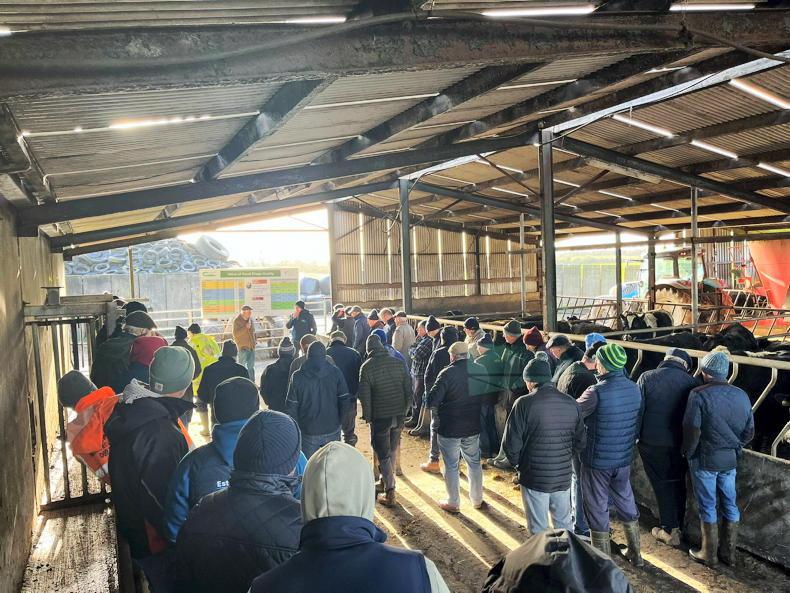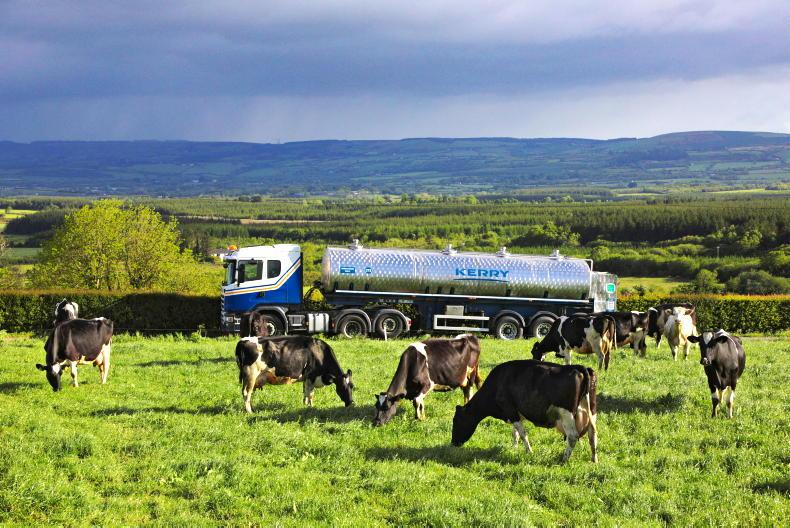With an agreement on agricultural emissions reduction levels now in place, we have an obligation to meet them. Tillage emissions are much lower than the livestock sectors, mainly because we do not have much methane to contend with. Tillage can more easily reduce emissions further and many farms could move to store more carbon than they emit.
One of the reasons why tillage has lower emissions is because tilled soils already lost a lot of carbon in the early years of cultivation. Now we are operating at the lower plateau of soil organic matter or carbon level.
Background
Carbon in our soils is mainly stored as organic matter, both plant and animal. This can be present as recent plant material or organic manure and can be readily broken down by organisms living in the soil, which use it as a source of energy or food.
When this is being broken down, the living organisms give off carbon dioxide (CO2) in the process and this is largely how carbon is lost from the soil to the atmosphere. Carbon is also moved out in grain and straw.
Some of the organic matter finds its way into structures which protect it from degradation by microorganisms and this makes it more stable in the soil. This is very often tied up within soil particles, but as we cultivate finely, we increase access to it by soil microorganisms.
The destruction of this organic matter results in furhter soil structure loss in tillage soils. Loosening of the soil increases oxygen availability and microorganism activity. So, fine cultivation, plus increased oxygen availability, speeds up organic matter loss.
Cultivation intensity
As a general rule, the more intensive and deep the cultivation the greater is the likelihood of organic matter and carbon loss.
One of the principles behind min-till and direct drilling is to decrease oxygen availability to help minimise the loss of carbon from tillage soils.
Farmers may feel that there is no significant further loss now that soil organic matter levels are low. This is somewhat true, but what if you were paid to increase soil carbon?
There is little point in spending time, effort and cost doing things to increase soil carbon while also doing something else that is accelerating its loss. And increasing soil carbon is fundamentally good for yield potential.
Reduced intensive cultivation will become a feature of tillage.
That is not to suggest that the plough will not be used, but as we act to improve soil health through added organic matter, soil becomes easier to manage. For many, the plough will become a rotational tool associated with specific crops or as part of an integrated weed management system – plough down seeds and leave them there for a few years.
Soil health
Tillage farmers should be most concerned about soil health. A healthy soil needs to be well structured to enable maximum root growth, have good fertility to supply nutrients to the growing crop and have active soil biology to tie it all together.
Soils are damaged by a combination of weather, machinery and livestock. Damage means a loss of or reduction in porosity, which affects many aspects of soil function.
A well-structured soil is critical for maximum root growth, which is correlated with plant growth.
Damaged soil can be repaired by active soil biology if it is fed with organic matter. This is headed up by earthworms, which are key to soil structure repair.
Soil microorganisms do many other things in the soil. They help break down organic matter to release nutrients, some act to prevent diseases like take-all and others help plant roots to take up nutrients more efficiently.
While the process of building soil organic matter will necessitate the loss of some carbon, it will still be incrementally improved.
Higher soil
organic matter
Advantages:
Soil is easier to cultivate: Less diesel and wider working windows.More mineralisation: Crop is fed by nature in some of the critical yield formation stages to give higher yield potential.Moisture retention: Soils with higher organic matter levels hold more moisture to make light soils more resilient in dry years. Water infiltration: Organic matter helps biological activity to make soils more porous and enable better water infiltration.Nutrient availability: Soils with higher humus levels store nutrients in a more available manner for plant roots.Biological activity: Higher organic matter will support more biological activity to store more carbon in the microbes themselves, while adding to natural biodiversity.Nutrients: Organic matter can bring with it a supply of plant nutrients.Carbon: Higher organic matter means more carbon stored.Disadvantages:
I could leave this section empty, but that would be untrue. Actions to improve and increase soil organic matter take both time and money and the responses are not instant.
Cost: The provision of additional organic matter will add to cost through the spreading of organic matter, the loss of the cash value of straw or the costs associated with putting in catch crops.Time: Virtually all measures taken to increase soil organic matter involve time, which has a direct or indirect cost.Carbon: The old adage “you must speculate to accumulate” applies here. Actions to increase soil organic matter involve the use of additional diesel and metal, which means a direct carbon cost for doing the job. The challenge is to ensure that the benefits outweigh the costs. While tillage is a low emissions sector, we can do more.
Increasing soil organic matter level will mean more carbon stored, but it will also mean higher yield potential for the grower.
Increasing soil organic matter and biological activity will help to decrease the energy requirement for soil engaging activities.
With an agreement on agricultural emissions reduction levels now in place, we have an obligation to meet them. Tillage emissions are much lower than the livestock sectors, mainly because we do not have much methane to contend with. Tillage can more easily reduce emissions further and many farms could move to store more carbon than they emit.
One of the reasons why tillage has lower emissions is because tilled soils already lost a lot of carbon in the early years of cultivation. Now we are operating at the lower plateau of soil organic matter or carbon level.
Background
Carbon in our soils is mainly stored as organic matter, both plant and animal. This can be present as recent plant material or organic manure and can be readily broken down by organisms living in the soil, which use it as a source of energy or food.
When this is being broken down, the living organisms give off carbon dioxide (CO2) in the process and this is largely how carbon is lost from the soil to the atmosphere. Carbon is also moved out in grain and straw.
Some of the organic matter finds its way into structures which protect it from degradation by microorganisms and this makes it more stable in the soil. This is very often tied up within soil particles, but as we cultivate finely, we increase access to it by soil microorganisms.
The destruction of this organic matter results in furhter soil structure loss in tillage soils. Loosening of the soil increases oxygen availability and microorganism activity. So, fine cultivation, plus increased oxygen availability, speeds up organic matter loss.
Cultivation intensity
As a general rule, the more intensive and deep the cultivation the greater is the likelihood of organic matter and carbon loss.
One of the principles behind min-till and direct drilling is to decrease oxygen availability to help minimise the loss of carbon from tillage soils.
Farmers may feel that there is no significant further loss now that soil organic matter levels are low. This is somewhat true, but what if you were paid to increase soil carbon?
There is little point in spending time, effort and cost doing things to increase soil carbon while also doing something else that is accelerating its loss. And increasing soil carbon is fundamentally good for yield potential.
Reduced intensive cultivation will become a feature of tillage.
That is not to suggest that the plough will not be used, but as we act to improve soil health through added organic matter, soil becomes easier to manage. For many, the plough will become a rotational tool associated with specific crops or as part of an integrated weed management system – plough down seeds and leave them there for a few years.
Soil health
Tillage farmers should be most concerned about soil health. A healthy soil needs to be well structured to enable maximum root growth, have good fertility to supply nutrients to the growing crop and have active soil biology to tie it all together.
Soils are damaged by a combination of weather, machinery and livestock. Damage means a loss of or reduction in porosity, which affects many aspects of soil function.
A well-structured soil is critical for maximum root growth, which is correlated with plant growth.
Damaged soil can be repaired by active soil biology if it is fed with organic matter. This is headed up by earthworms, which are key to soil structure repair.
Soil microorganisms do many other things in the soil. They help break down organic matter to release nutrients, some act to prevent diseases like take-all and others help plant roots to take up nutrients more efficiently.
While the process of building soil organic matter will necessitate the loss of some carbon, it will still be incrementally improved.
Higher soil
organic matter
Advantages:
Soil is easier to cultivate: Less diesel and wider working windows.More mineralisation: Crop is fed by nature in some of the critical yield formation stages to give higher yield potential.Moisture retention: Soils with higher organic matter levels hold more moisture to make light soils more resilient in dry years. Water infiltration: Organic matter helps biological activity to make soils more porous and enable better water infiltration.Nutrient availability: Soils with higher humus levels store nutrients in a more available manner for plant roots.Biological activity: Higher organic matter will support more biological activity to store more carbon in the microbes themselves, while adding to natural biodiversity.Nutrients: Organic matter can bring with it a supply of plant nutrients.Carbon: Higher organic matter means more carbon stored.Disadvantages:
I could leave this section empty, but that would be untrue. Actions to improve and increase soil organic matter take both time and money and the responses are not instant.
Cost: The provision of additional organic matter will add to cost through the spreading of organic matter, the loss of the cash value of straw or the costs associated with putting in catch crops.Time: Virtually all measures taken to increase soil organic matter involve time, which has a direct or indirect cost.Carbon: The old adage “you must speculate to accumulate” applies here. Actions to increase soil organic matter involve the use of additional diesel and metal, which means a direct carbon cost for doing the job. The challenge is to ensure that the benefits outweigh the costs. While tillage is a low emissions sector, we can do more.
Increasing soil organic matter level will mean more carbon stored, but it will also mean higher yield potential for the grower.
Increasing soil organic matter and biological activity will help to decrease the energy requirement for soil engaging activities.










SHARING OPTIONS